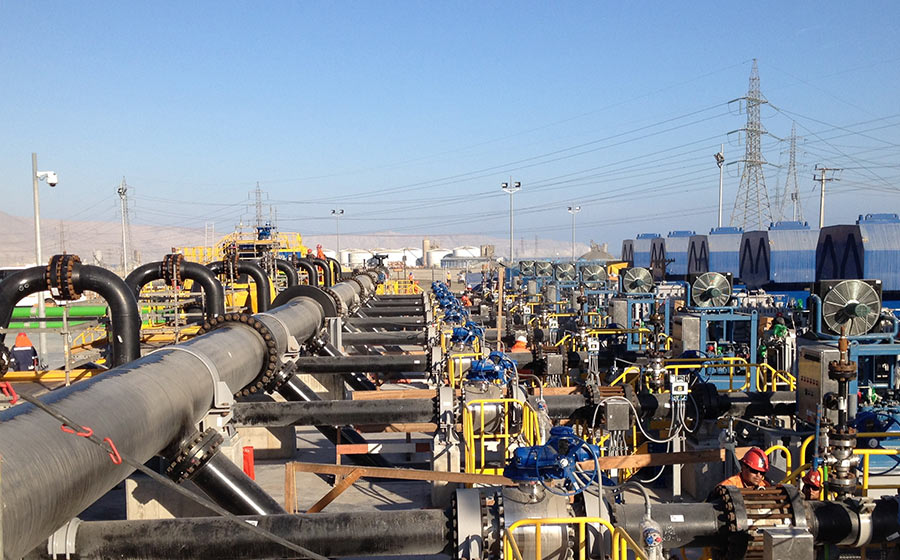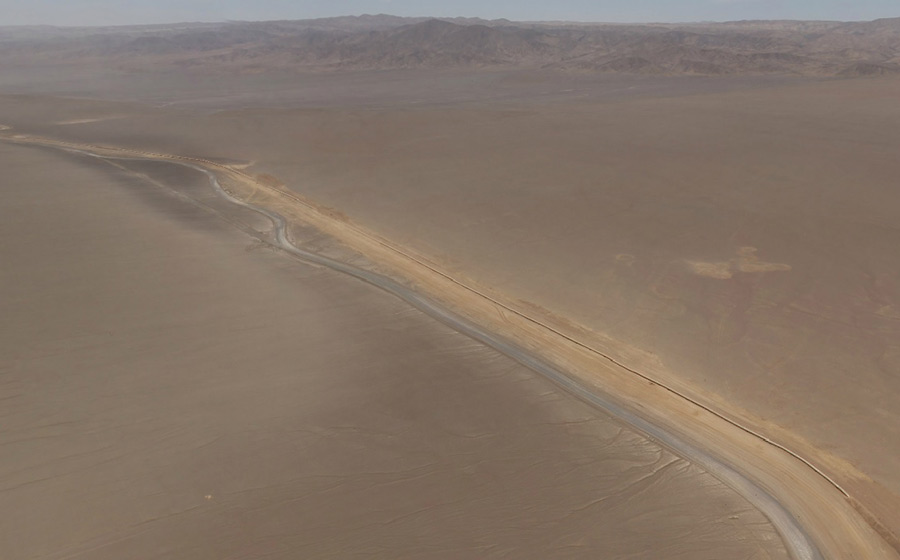KGHM – world’s largest silver and eighth biggest copper producer – has confirmed the on-schedule construction of the 142 kilometre Seawater Pipeline in the Sierra Gorda mine in Chile. Sierra Gorda mine is world’s seventh largest copper project. With excellent health and safety performance, work is continued towards the mine’s technical commissioning and initial production in mid 2014. To date, the overall project progress is already above 90%.
The Sierra Gorda project is located in the Antofagasta region within the Atacama Desert, which is Chile’s largest copper producing region. It will produce copper, molybdenum and gold ore by open pit methods. Downstream processing will include crushing, grinding, flotation and drying to obtain copper and molybdenum concentrates. When production begins, the Sierra Gorda mine will process daily 110,000 tons of ore, producing 120,000 tons of copper per year. In addition, the project will be one of the largest molybdenum producers in the world, averaging about 50 million lbs. of molybdenum production each year during the first years of the mine’s life.
Sierra Gorda will operate using seawater captured from the cooling systems at a thermal electricity generating plant, located on the coast of Mejillones. Instead of being discharged into the sea, the water will be transported to the Sierra Gorda mine and plant through a 142.6 kilometre pipeline passing inland over a coastal plain and hills. Apart from the pipeline itself, its key infrastructure includes the coastal station and two inland pump stations, with a total of 24 pumps and pumping rate of 1,500 litres per second. Additionally, port facilities and fibre optic cable all along the pipeline were provided.
“Our project is located in a desert, with extremely dry conditions and scarce water reserves. That is why our top priority was securing water supply and eliminating the risk of exhausting this resource in the region. An important design innovation was made to incorporate the use of sea-water on the project site through the pipeline,” said Jarosław Romanowski, Executive Vice President and CFO of KGHM.

The pipeline’s hydraulic tests, which were critical to the project’s commissioning, were executed from December 14, 2013 and successfully completed on February 28, 2014. Seawater pumping to cumulative pond of 750,000 cubic meters capacity will start in March 2014.
“We are proud to see the on-time delivery of the pipeline construction, with all hydraulic and pressure tests for the pipe and pump stations. This success is definitely one of the key milestones towards technical commissioning of the Sierra Gorda project, which is planned for June 2014”, said Maciej Ściążko, General Manager at Sierra Gorda SCM. “The whole project development, from exploration to initial production, took 10 years, which is considerably shorter than a project of this size normally takes.”
 After the start of production, the Sierra Gorda mine will use 251,808 cubic meters of water daily. On a yearly basis, this equals a capacity of 92 million cubic meters. As planning is underway to increase ore processing from the initial 110,000 tons per day to 190,000 tons per day, which would result in average annual copper production of about 220,000 tons over a 20 year-life, the amount of water used daily in the mine will grow to 442,000 cubic meters daily.
After the start of production, the Sierra Gorda mine will use 251,808 cubic meters of water daily. On a yearly basis, this equals a capacity of 92 million cubic meters. As planning is underway to increase ore processing from the initial 110,000 tons per day to 190,000 tons per day, which would result in average annual copper production of about 220,000 tons over a 20 year-life, the amount of water used daily in the mine will grow to 442,000 cubic meters daily.
With this volume of water, the Sierra Gorda project has been designed so that it will not discharge effluent into the environment, ensuring that the quality of groundwater is not affected. Wells have been installed to monitor the levels and quality of the water and allow any seepage to be immediately detected and collected. Additionally, during construction of the pipeline all precautions were made to protect the nesting grounds of highly mobile fauna species, especially Peruvian tern (Sterna lorata) and Garuma gull (Larus modestus).

The project also reports excellent health & safety performance compared to industry standards. The 2013 total recordable incident rate (TRIR) for Sierra Gorda employees and contractors was 0.18 which is an “Industry Best”. KGHM’s core values – Zero Harm, Success Through Teamwork, Results Driven and Courageous Leadership – as well as a strong team culture between employees and contractors are an important part of this success. This record has also won the recognition of various independent institutions, including Chile’s Labour Office and the National Mining and Geology Service (Servicio Nacional de Geología y Minería).
* * *
Sierra Gorda SCM, operated by KGHM International, is a joint venture between KGHM (55%), Sumitomo Metal Mining (31.5%) and the Sumitomo Corporation (13.5%).
KGHM is world’s largest silver and eighth biggest copper producer, with the 4th biggest copper re-serves and over half a century of experience. It has a broad portfolio of producing, development and exploration projects, spanning the globe in Poland, Germany, Canada, Chile and the USA.
Sumitomo Metal Mining is the third largest copper producer and the largest nickel and gold producer of Japan, with head offices in Tokyo. Sumitomo Corporation is devoted to the marketing of products of various industries, including the mining industry. It is one of Japan’s 8 largest companies.





